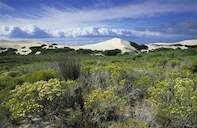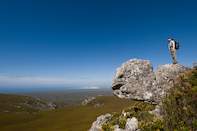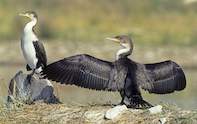Picture of Tranquility and Beauty
The De Hoop (Hope) Nature Reserve is located in the Overberg of the Western Cape. It has a main entrance where the road winds down through hills of limestone fynbos resplendent with proteas, ericas and restios. The main camp is set on an inlet of De Hoop Vlei: one sweep of the binoculars could take in dozens of Coots, Cormorants, Ducks, Geese, Pelicans and a pair of Fish Eagles.
The bush around the reserve cottages, overlooking a tongue of lagoon, is equally well trafficked. Canaries, Robins, Mouse Birds, Weavers and Boubous flit about, trying to steal scraps from the braai grid, and a Francolin family seem to only just tolerate a human’s presence. The Eland, Bonteboks and Mountain Zebras are so accustomed to guests that they wander between the cottages unconcerned. It is a serene picture of tranquility and beauty.
A Magical Spot

Nearby the cottages in the De Hoop Nature Reserve stands the De Hoop Manor House fronted by fig trees (Ficus natalensis) of outrageous proportions and a large open area. The ‘skew room’, built in 1738, is the oldest structure on the property. The homestead evokes the grander elements of Dutch design: central gables, imported materials, the fine workmanship of Malay slaves and rows of finely proportioned outbuildings.
A short drive to the coast leads to Koppie Alleen, a magical spot on a dune where thatched cottages sit above an enchanting beach. Beyond lay the hulls of southern right whales and their calves. Heads, flukes, spouts. The spring view is elemental: windswept dunes, limestone cliffs, myriad fynbos, shallows lined with shipwrecks…and dancing whales.
A Sense of Bygone Ages

By Justin Fox


 In De Hoop Nature Reserve you can see more rare and endangered species of mammal, bird, reptile and flower — than just about anywhere else...
In De Hoop Nature Reserve you can see more rare and endangered species of mammal, bird, reptile and flower — than just about anywhere else... De Hoop Nature Reserve is a large coastal reserve administered by CapeNature, and it is a little-known slice of paradise with much to offer ...
De Hoop Nature Reserve is a large coastal reserve administered by CapeNature, and it is a little-known slice of paradise with much to offer ...